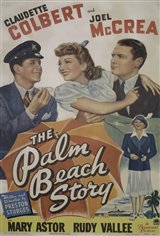
The Palm Beach Story
The Palm Beach Story
As for the opening reels, the principal motivating factor is money. After a deliberately confusing pre-credit sequence (not explained until the film's punch line), Tom Jeffers (Joel McCrea) and Gerry Jeffers (Claudette Colbert) are married. And so they lived happily ever after, exults a title card, ...or did they? Well, they didn't. After five years of marriage, Tom hasn't raised a dime with his pie-in-the-sky inventions. Using the sort of logic common to Sturges heroines, Gerry decides that the only way to help her husband is to divorce him, marry a wealthy man, and use the second husband's money to finance Tom's schemes. Borrowing money from a generous self-made business mogul known only as the Wienie King (Robert Dudley), Gerry boards a train to Palm Beach, FL, where all the rich folk go. En route, she is adopted by the Ale & Quail Club, a group of perpetually drunken millionaires whose idea of a good time is to shoot their rifles at everything that moves (among the club members are such Sturges regulars as William Demarest, Robert Warwick, Jimmy Conlin, Robert Greig, Jack Norton, and Dewey Robinson). Taking refuge from this rowdy crew, Gerry makes the acquaintance of likeable stuffed shirt John D. Hackensacker III (Rudy Vallee), who happens to be one of the wealthiest men in the Western Hemisphere. While Gerry spoons with Hackensacker in Palm Beach, the confused Tom (remember him?) dallies with Hackensacker's man-crazy sister, Princess Centimillia (Mary Astor). How all this straightens itself out is better seen than described, which is pretty much the case whenever one discusses Sturges' singular work, and The Palm Beach Story is vintage Sturges with one side-splitting sequence after another.
| Cast: | Sig Arno, Arthur Hull, Jimmy Conlin, Jack Norton, Sheldon Jett, Robert Dudley, Alan Bridge, Charles Moore, Frank Moran, Howard Mitchell, Monte Blue, Esther Michelson |
| Director: | Preston Sturges |
